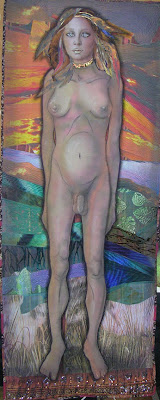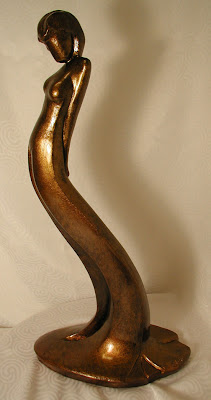Figured Out: Explorations of the Human Form
Review by Keith Waits
Entire contents copyright © 2012 Keith Waits. All rights reserved.
Throughout the history of modern art, images of the human form have been rejected, neglected, exploded and imploded to the point where, intellectually at least, one could argue the subject has been thoroughly exhausted – except that it hasn’t, and may never be. The use of the human figure in art can still allow us to turn a mirror on ourselves, whether to illuminate the complexity of our character or to simply confirm the narcissistic preoccupation with ourselves as the center of existence – it never fails to fascinate and still holds us in thrall.
Even a superficial examination of art history reveals that when the focus is the human figure itself, the images are predominantly female. A new exhibit at Kaviar Forge & Gallery is comprised mostly of work that continues to concentrate on the feminine, leavened with just enough unconventional twists to spice up the mix.
 |
| “What Lies Between Us,” cotton, hand-dyed silk, found beaded border, gold cord, shower curtain remnant, batik, ribbon, metallic spray paint, oil pastel, 31″ x 79″, Penny Sisto. |
Installed mostly on one wall, the first piece moving left to right is also one of the most arresting. Penny Sisto’s “What Lies Between Us,” the first of three quilts by the artist included here, is a vertical composition featuring a full-length human figure staring down at the viewer, a figure with the countenance and slender body of a young girl sporting female breasts and male genitalia. The gender confusion is underscored by a bold, aggressive juxtaposition of color, shape and texture that creates an unsettling emotional quality.
In another piece by this artist, “Crazy Quilt,” a large portrait of a woman’s face (she resembles Amy Winehouse) and breasts prove equally confrontational and unnerving. With the tilt of the head and eyes filled with accusation, the comfort and harmony associated with traditional quilt forms are abandoned entirely, replaced by aberrant psychological aspects that haunt rather than console the viewer. Each piece is hung for maximum effect, so that the genitalia of the former and the breasts of the latter fall at an approximate eye level, and the troubled gaze of each fall on you from a lofty perspective that intimidates ever so slightly.
 |
| “Libertine,” solid ceramic with metallic patina, 16″ tall with 8″x5″ base, 4 lbs, Chyre Boardman. |
Chrye Boardman has three ceramic sculptures in the exhibit, two of which offer a tidy exercise in the contrast of posture and attitude. “Libertine” illustrates a slightly abstracted female form with a dynamic upsweep, the impact of which belies the comparatively small size of the piece. The arms are pushing the pelvis forward and the shoulders pull back to emphasize the breasts enough to clarify the carnal intent of the figure. Conversely, “Softly Shy” diametrically opposes this expression, with the retreating posture drawing attention to the classic pose of vulnerability in which the hands cover the private parts. The forms are clean and economically crafted, with little detail to interrupt their iconic nature.
More traditional takes on the subject are offered by Claudia Hammer and Clinton Hobart. Both display assured craft and technical control in relatively straightforward studies of nude models. Ms. Hammer’s carefully observed oils are characterized by an acute sense of light and form; and in “Liz Reclining,” the figure is exquisitely captured in tight brushwork, yet surrounded within the frame by swift, broad strokes of color that contain the form. In Mr. Hobart’s oil paintings, the women recall an aesthetic of nude pin-ups from the middle of the 20th century, a bracingly nostalgic perspective that is accurate except in leaving behind the sexism of the period in favor of a dash of psychological complexity.
 |
| “Moody Nude,” pastel on paper, 18″x26″, Sharon Matisoff. |
This last quality is pushed even further in Sharon Matisoff’s “Moody Nude,” in which we encounter a model whose thoughts seem far distant from her circumstance, and the shadings of human emotion are made manifest in both the troubled facial expression and the vivid and expressionistic range of colors in the skin tone and background: warm, creamy Caucasian hues clashing with intense purples.
Some of the work includes the human form in somewhat more oblique or reduced fashion. Craig Kaviar’s copper reliefs, such as “Bacchus with Nymphs and Cupid,” are figurative to be sure, yet the forms are captured beneath an aged surface and utilized more as graphic elements in illustrating the classical mythology of its source, so that the human images are somewhat deemphasized in comparison to the other artist’s work that surrounds them. In yet another variation, the wood and glass constructions of Sergio Vettori employ tiny male forms as focal points in modestly-scaled sculptures and boxes that are precious in their appeal. Most striking is “Taken,” in which the figure is balanced upon a precarious network of glass tubes that blend the sensibilities of Rube Goldberg and M.C. Escher.
| “An Innocent Desire to Know,” oil on panel, 9″x12″, Mark Selter. |
Finally, there are three small oils by Mark Selter that are worthy examples of the rich, sensual technique that characterizes this artist’s best work. In paintings such as “An Innocent Desire to Know,” which depicts Eve about to face the serpent’s temptation, his human figures take center stage in narrative compositions that are as carefully formed as they are luxurious in their texture. Mr. Selter’s compositions are reminiscent of classic masters, but his insightful attitude is entirely modern.
A visit to the gallery is worthwhile, but to witness the “complete” exhibit one might consider it essential to attend the F.A.T. Friday reception on March 30, where the artist known as W.A.R. will be on hand to create a unique work, painting performance artist Monet Magnolia.
Figured Out: Explorations of the Human Form
March 2-May 19, 2012
F.A.T. Friday Receptions March 30 & April 27
March 30th event features performance artist Monet Magnolia painted by the artist known as W.A.R.
Kaviar Forge & Gallery
1718 Frankfort Avenue
Louisville, KY 40206
502-561-0377





My examination of art history, in regard to nudity in art and a focus on the human figure, did not reveal the same perspective as Mr. Waits’. When I studied art history, I saw a lot of images of male nudes. During the Archaic period in Greek art, female nudity was not an acceptable subject for public display. During the classical period in Greek art, the male nude predominated. The Greeks were obsessed with the idea of the beautiful male body.